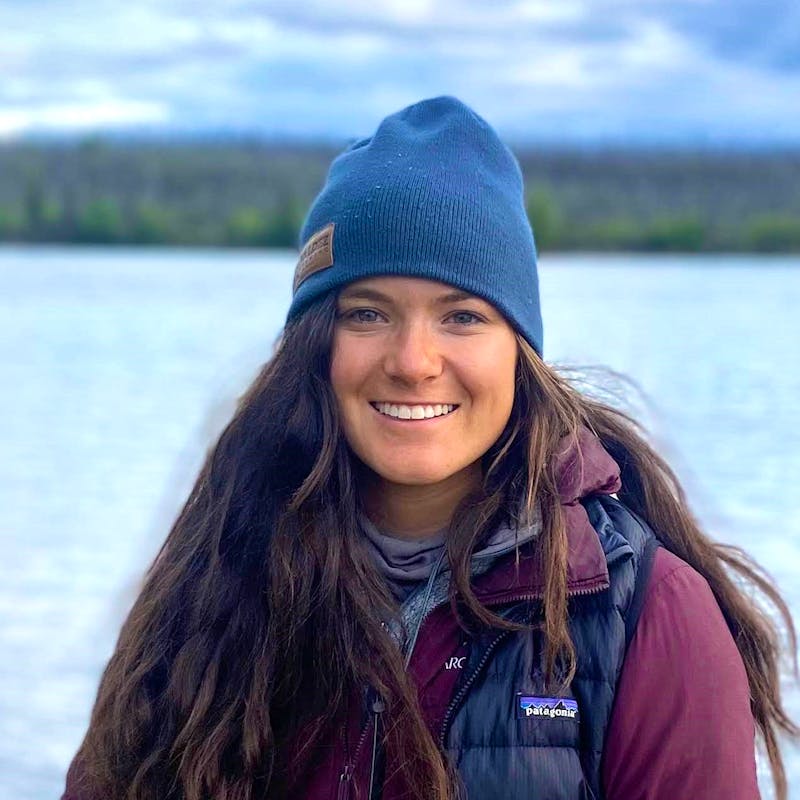If you think back to your high school geology class, you may recall learning about seismic waves which are acoustic energy that travel through Earth. We often associate seismic waves with natural disasters like earthquakes which are the result of these waves causing sudden movement along a fault line. Earthquakes, big and small, happen all the time and most don’t even register with us. Some earthquakes, however, can be quite destructive, particularly if they occur near populated areas. Alaskans may remember the infamous 2018 7.1 magnitude earthquake.
The seismic activity we’re talking about today, however, isn’t the kind wrought by nature but rather by industrial machinery, unleashed across fragile Arctic landscapes in hopes of finding natural gas and oil.
Picture a mother polar bear, quietly curled up in her den beneath the snow. She’s fasting through the long winter while nursing a newborn cub, who weighs barely a pound. BOOM. Thunderous sounds and vibrations of heavy machinery shatter this tender moment. In confusion and fear, the mother abandons her cub.
This stark vision may be a reality for polar bears denning in the Arctic National Wildlife Refuge this winter if seismic testing takes place.
What is seismic exploration?
Seismic exploration is the oil and gas industry’s attempt to “see” underground. They intentionally generate controlled acoustic waves sent into the earth and measure how those waves reflect off underground structures to locate hidden reserves of fossil fuels.




To be successful in penetrating deep enough into the Earth, seismic exploration demands large-scale operations: many source points, dense receiver spacing, long survey lines, and massive support infrastructure. This means fleets of heavy vehicles, camps, fuel, supplies, and continuous operations. And they cover hundreds or thousands of square kilometers, with grid networks crisscrossing remote terrain.
How does seismic exploration impact the tundra?
In remote or fragile regions like the tundra, permafrost and Arctic coastal plains, seismic efforts face extra constraints and risks. Because the land is sensitive, operators are limited to periods when the ground is sufficiently frozen and insulated by snow cover.
Even under “ideal” winter conditions, however, damage occurs. Vehicle tracks compress snow and soil, damage vegetation, disrupt surface morphology and break thermal insulation. Over time, such scars alter permafrost stability, hydrology or surface drainage.
The microtopographic features — small mounds, tussocks, ice-wedge polygons — are especially vulnerable. If a vehicle track slices into variations of the ground’s surface, it can channel water differently, causing pooling or exacerbate thawing around edges. Groundwater flow and wetland integrity may also be affected.
In landscapes underlain by permafrost, disturbing the insulating surface layers — organic soil, moss, tundra — can lead to localized thawing, thermokarst development (“pits”), and degraded ground stability. Such changes may not show immediately but can worsen over time, especially under warming climate conditions. Additionally, thawing releases greenhouse gases or changes carbon cycling, further warming the Arctic.
In tundra, plant growth is slow, and in Arctic settings many plants are fragile and specialized. Some areas may take decades to recover — if ever — to pre-disturbance conditions.
Because seismic surveys often require mobile camps, supply chains, fuel transportation and storage, waste management, airstrips and regular overflights, and land access routes, the footprint is far greater than just the seismic lines themselves. It includes all infrastructure and support. The expansive camps are dragged on sleds from one location to the next, further expanding the damage to the land.
How does seismic exploration impact polar bears?
To add insult to injury, seismic testing takes place in December when there is enough snow cover and just as mother polar bears have entered their dens to bear and rear newborn cubs.
Due to sea ice becoming thinner over the last three decades, there’s been a shift to maternity dens being constructed on land. Based on data from radio-tagged adult female bears in the Southern Beaufort Sea population, maternal denning is occurring at relatively high densities along the Arctic coastal plain of Alaska. The Arctic Refuge is the most important land-based denning habitat for Southern Beaufort Sea bears with 76% of the coastal plain designated as polar bear critical habitat.
Disturbance to bears is a major concern. A single truck can crush a den, destroying it entirely. Even if a den is not physically damaged by seismic noise or vibrations, other risks remain. The presence of heavy vehicles, human activity and acoustic or vibrational disturbances might cause den abandonment, early cub emergence or stress to the mother bear. Early emergence is dangerous because cubs are vulnerable to cold temperatures and predation.
Even with the required Forward Looking Infrared Radar surveys to detect dens, over half of the dens are missed or unidentified. Additionally, terrain alteration in denning zones may reduce the availability of suitable denning habitat over time. Scarring of the surface, changes in surface texture, and sinking of the ground surface may degrade areas making them less suitable for future denning.
How does seismic exploration impact other animals?
Caribou, foxes, wolves, muskoxen and smaller mammals may avoid areas of activity or suffer from habitat fragmentation. Roads and trails can act as barriers or shifting corridors. Additionally, in Arctic coastal zones, seismic grids may crisscross bird nesting or migratory pathways, trampling nests or disturbing breeding behavior.
Help Protect the Arctic
Seismic testing is a major disturbance to Alaska’s arctic. Mitigation measures can’t eliminate the risks to the Arctic’s animals or the decades-long lasting scars on the pristine landscape. At a time when the Arctic is already facing the impacts of climate change, adding more industrial pressure is reckless. For Alaska’s wildlife, especially its most vulnerable denning polar bears, the price is simply too high.
You can help support Defenders of Wildlife’s work on protecting Alaska’s arctic by letting your representatives know you do not support drilling in the Arctic Refuge.














